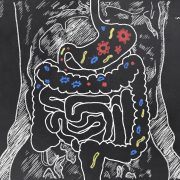USANA Probiotic
Trust Your Gut to USANA® Probiotic
USANA® Probiotic
Support your digestive and immune health with a beneficial blend of proven bacteria strains delivered in a convenient powdered formula.*
Your gut is at the core of good health. Everything you ingest must go through your digestive system to be broken down into the micro- and macronutrients your cells need to function properly. Imbalances in the gut can disrupt this process, starting a vicious cycle that could bring discord to your health and your life. USANA Probiotic can help maintain healthy harmony by bringing balance to your belly.*
By supplying an increase of friendly bacteria to the gut, USANA Probiotic helps create an ideal environment to keep things running smoothly. Taking one stick pack every other day offers important benefits for your daily health and well-being:
- Promotes good digestion and nutrient absorption*
- Maintains digestive comfort and regularity*
- Supports healthy immunity*
Not all probiotic sources are equal. Make sure you get a real, reliable dose of beneficial bacteria every time with USANA Probiotic. Each stick pack contains guaranteed levels of two of the most well-studied probiotic strains. So you can feel confident that you’re getting what you need.
USANA Probiotic is a sugar-free, gluten-free, and dairy-free powder. And, it’s easy to use. The mildly sweet formula mixes with any cold food or beverage. Or you can just take it straight from the package.
When it comes to a quality supplement for your digestive and immune health, trust your gut to USANA® Probiotic.*
Beneficial Bacteria Are Vital for Good Digestive Health
Your body’s functions are fueled by the food you eat. So, maintaining digestive health is an important factor in getting the nutrients you need. Because your digestive system is responsible for breaking down and absorbing all the nutrients from the food and supplements you consume.
Digestion is a multi-step process. It begins in your mouth and ends when wastes are eliminated.
Your gastrointestinal (GI) system is central to the process. It hosts trillions of bacteria—also known as microflora. Your body and its microflora adapted to form a mutually beneficial relationship. The bacteria help your digestive process function properly. The bacteria flourish because they feed on the by-products of digestion. This is why—out of your whole body—the highest amount of bacteria is found in your gut microbiome.
Is it “microbiome” or “microbiota”?
You may have heard the term “microbiome” and “microbiota” and wondered what the difference is. It’s generally acceptable to use the terms interchangeably, so we use “microbiome” here at Ask the Scientists. “Microbiome” is well-recognized throughout the scientific community and has become the preferred term. Likely because it’s the most comprehensive. Technically “microbiome” and “microbiota” are slightly different.
- In people, the microbiota is the whole community of microbe species found at a particular site on the human body. This includes fungi, bacteria, viruses, etc., that live in one place. In other words, you have a gut microbiota, a skin microbiota, a urinary tract microbiota, etc. The communities of microbes on your body are generally stable…but they’re also variable. Every site on your body has a different makeup. And it can fluctuate over time.
- The microbiome is all of the microbes in the microbiota plus their genes. The microbiome is vast. It has been estimated that there are 3.3 million unique genes in the human gut microbiome alone, compared to about 22,000 genes present in the entire human cell genome!
Bacteria serve many purposes in the digestion and metabolism process, including:
- Supporting the activity of enzymes that break down fats, carbohydrates, proteins, vitamins, minerals, and polyphenols into useable forms.
- Producing some nutrients—bacteria in the gut make vitamin K, biotin, and more.
- Helping to remove toxins and wastes from the body through the normal passage of stool through the colon.
There are thousands of different species of bacteria in your digestive tract. They can be both beneficial or potentially harmful. Maintaining the right balance of the right bacteria for you is the key.
A number of things can upset the stability of your intestinal environment, including the following:
- Occasional stress
- Poor diet and hydration
- Lack of rest or changes in sleep patterns
- Travel and exposure to new microbes
The normal aging process also impacts the stability of your gut microbiome. Older adults may have differences in their gut caused by changes in their nutritional status and lifestyle.
To keep everything working smoothly, it is vital that you drink plenty of water; exercise; and consume a proper diet that includes plenty of fiber from fruits, vegetables, and whole grains. In addition to eating a healthful diet, you can also add a probiotic supplement to support a healthy balance.*
What does a probiotic supplement do? The Food and Agriculture Organization of the United Nations defines probiotics as “live microorganisms that, when administered in adequate amounts, confer a health benefit on the host.” That’s a predictably stuffy way for an official agency to say that a probiotic supplement will help replenish beneficial bacteria to help keep you healthy.*
USANA Probiotic delivers goodness to your gut with probiotic bacteria specifically selected for their belly benefits.*
Bring Balance to Your Belly’s Bacteria with USANA Probiotic
Aid good digestion and support your overall health with USANA Probiotic. It supports harmony in your GI tract by helping to establish a better microbial balance with a boost of friendly bacteria.*
There are many probiotic supplements available on the market today. USANA Probiotic makes an excellent choice for two key reasons: the strains and the amounts used.
1—contains two strains of bacteria shown to colonize the intestines and deliver health results
Each stick pack of USANA Probiotic contains a unique 50/50 mixture of two of the most studied probiotic bacteria strains: Bifidobacterium animalis subsp. lactis (BB-12®) and Lactobacillus rhamnosus (LGG®). These bacteria are similar to the Bifidobacterium and Lactobacillus that are part of a natural gut flora (primarily found in the colon). Dozens of studies on these strains have demonstrated benefits for digestive health and immunity.*
These strains are so effective, in part, because they survive transit through the harsh, acidic environment of the stomach to colonize the intestines. Reaching the intestines alive is essential for getting results from your probiotic. The strength of the strains is boosted by a small amount of inulin fiber in the formula. Inulin acts a prebiotic, which feeds your natural beneficial bacteria and may further support establishment of Bifidobacterium in the intestine.*
What does LGG and BB-12 mean?
Lactobacillus LGG has been replicated from a human intestinal microbiota. It was discovered by Professors Gorbach and Goldin, giving name to the strain.
BB-12 is a lactic-acid producing bacteria that comes from a proprietary dairy culture collection. When it was first classified, it was thought to belong to the species Bifidobacterium bifidum, which is where the “BB” came from. Though the classification has now changed to Bifidobacterium animalis subsp. lactis, the name has not.
LGG is a registered trademark of Valio Ltd.
BB-12 is a registered trademark of Chr. Hansen
2—delivers a reliable amount of live bacteria to provide real benefits—even after 18 months
Generally, at least one billion Colony Forming Units (CFU) of total active bacteria are needed daily to provide probiotic effects throughout the GI tract. But most of the yogurts or other foods people rely on to get their beneficial bacteria contain an unspecified or unverified number of viable bacteria.
So, if you’re relying on yogurts to replenish your beneficial bacteria, it certainly won’t hurt your health. But it might not really be helping it either.
Take away the guesswork with a product that you can trust will deliver an amount of bacteria with real belly benefits. USANA Probiotic is guaranteed to contain 12 billion CFU of active bacteria when it’s made—a level shown to be effective in clinical studies.*
And even months after manufacture, USANA’s 12 billion CFU-level is still stable.
Stability can be a challenge with some strains of bacteria—even when refrigerated. So, their shelf-life is short. But USANA’s blend is designed to remain stable at room temperature (25° C) for 18 months. This stability has been verified in independent and in-house tests. And, you can preserve your probiotics even longer by storing them in the refrigerator (which is advised in hot or humid climates).
Keep Your Tummy Calm
Occasional mild gas, constipation, bloating, and diarrhea can all be embarrassing and uncomfortable. You can help reduce the chance of physical discomfort by creating an ideal environment for healthy digestion with USANA Probiotic. (If you often have concerns with digestive issues, please talk to your doctor.)*
By maintaining a balanced digestive system, USANA Probiotic helps keep things moving. It has benefits for bowel regularity. It aids consistent waste elimination from the body through the regular passing of stool and normalization of stool consistency. It can also help maintain digestive health and comfort while traveling.*
Occasional stress—from travel, hectic schedules, or other lifestyle disruptions—can also take a toll on your digestion and cause minor GI upsets.
To help ward off any unpleasant side effects during stressful times, make supplements like USANA Probiotic part of your self-care. Taking vitamins and minerals, probiotics, and magnesium supplements for one month has been shown to help reduce levels of psychological stress and fatigue and improve feelings of well-being. A study in marathon runners also found that three months of probiotic supplementation was supportive in restoring normal GI function after race day.*
A Healthy Gut is a Strong Barrier
Supporting a healthy gut with USANA Probiotic can also help you stay well, even when you’re under pressure. Research suggests that probiotics, including Bifidobacterium BB-12 and Lactobacillus rhamnosus LGG, may play a role in sustaining healthy immune function.*
More immune cells are found in the gut than in any other region of the body. This makes sense, because a healthy GI tract is a central line of immune defense. Because it serves as a protective barrier.*
USANA Probiotic supports immunity through strength in numbers. Your natural bacteria line the wall of your GI tract to help support a strong barrier and maintain normal function. By delivering more friendly bacteria to your gut with USANA Probiotic, you are helping reinforce this activity. There’ll be even more good bacteria to fill attachment sites on the intestinal wall. So, your gut barrier will be fortified, helping you to stay healthy.*
Usage
Adults, add the contents of one stick pack to your favorite cold food or beverage and consume immediately. Take one stick pack every 1–2 days, or as needed to promote digestive health.*
Keep out of reach of children. Consult your physician if you have an autoimmune disorder, are taking immunosuppressant medication, are pregnant or nursing, taking a prescription drug or have a medical condition.
Ideal For
- Healthy adults of all ages
- Athletes
- People under temporary stress
- Travelers
Frequently Asked Questions About USANA Probiotic
Can USANA Probiotic be mixed with any food or beverage?
The most convenient way to take USANA Probiotic is consuming it straight from the stick pack. USANA Probiotic can be added to cold food and beverages. We do not recommend mixing it with boiling or hot liquids. High temperatures can reduce the effectiveness of the product.
If you decide to mix USANA Probiotic into a separate food or beverage, please consume the mixture within a reasonable timeframe (less than 30 minutes or so). This will help minimize any potential loss of potency.
Why does the USANA Probiotic powder vary in appearance?
It is not uncommon for USANA’s Probiotic powder to vary slightly in color (typically between white and light-pink). This effect is sometimes referred to as “pinking.”
Please note that any variance in coloring is not a quality concern. There is no relationship between “pinking” and viability of the probiotic product. Color changes to the product may be promoted by elevated temperature and humidity, but please understand that changes occur even during ideal storage conditions.
Again, any change in color is unrelated to changes in quality or effectiveness of the product.
Can I give USANA Probiotic to my child or teen?
While USANA Probiotic is labeled for use by healthy adults, there is some research that supports probiotic use in children. We recommend you discuss this with your child’s health care professional to determine if USANA Probiotic is appropriate for them.
Can I use USANA Probiotic while pregnant or breastfeeding?
USANA Probiotic is generally safe to use during pregnancy. And there is some research that shows benefits of probiotic use for a healthy pregnancy and for infant health during breastfeeding.* We recommend you discuss with your health care provider.
References
Kechagia, M, et al. 2013. Health benefits of probiotics: a review. ISRN Nutr [Internet] [accessed 4 June 2018] Available at https://www.ncbi.nlm.nih.gov/pmc/articles/PMC4045285/#B3
Jungersen M, et al. 2014. The Science behind the Probiotic Strain Bifidobacterium animalis
subsp. lactis BB-12®. Microorg 2: 92-110.
Guarner F, Malagelada JR. Gut flora in health and disease. 2003. Lancet 361(9356):512–9.
O’Hara AM, Shanahan F. The gut flora as a forgotten organ. 2006. EMBO Rep 7(7):688–93.
Sears CL. A dynamic partnership: Celebrating our gut flora. 2005. Anaerobe 11(5):247-251.
You Might Also Enjoy
Your Gut Microbiome’s Reaction to Dietary Fiber
A great way to support a lush, diverse microbiome is to eat a variety of fiber-rich foods.
Defining Microbiome: Meet Your Bacterial Buddies
You’re never alone. Your body is always crawling with trillions of microbial friends. That’s not a bad thing. All of them make up your microbiome.
There are big differences between macronutrients and micronutrients. Learn how to tell your nutrients apart so you can design your diet. And discover the three types of macronutrients and micronutrients.
*These statements have not been evaluated by the Food & Drug Administration. This product is not intended to diagnose, treat, cure, or prevent any disease.











